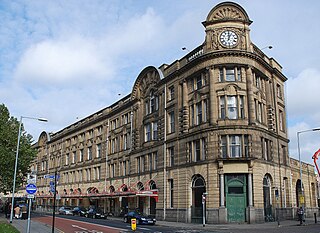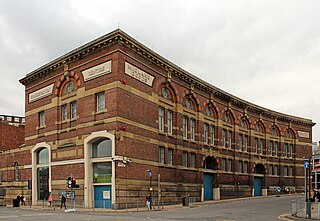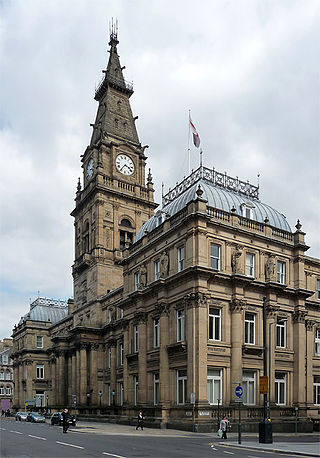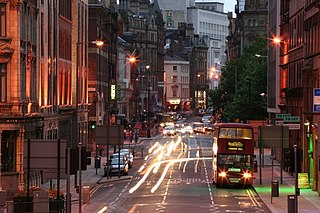
Manchester Victoria station in Manchester, England, is a combined mainline railway station and Metrolink tram stop. Situated to the north of the city centre on Hunts Bank, close to Manchester Cathedral, it adjoins Manchester Arena which was constructed on part of the former station site in the 1990s. Opened in 1844 and part of the Manchester station group, Manchester Victoria is Manchester's second busiest railway station after Piccadilly, and is the busiest station managed by Northern.

Manchester Oxford Road railway station is a railway station in Manchester, England, at the junction of Whitworth Street West and Oxford Street. It opened in 1849 and was rebuilt in 1960. It is the third busiest of the four stations in Manchester city centre.

The National Conservation Centre, formerly the Midland Railway Goods Warehouse, is located in Liverpool, Merseyside, England. It stands in a block surrounded by Victoria Street, Crosshall Street, Whitechapel, and Peter Street. After it closed as a warehouse it was converted into a conservation centre for National Museums Liverpool in the 1990s. Initially its exhibition area was open to the public, but this closed in 2010. The centre is recorded in the National Heritage List for England as a designated Grade II listed building.

Liverpool Exchange railway station was a railway station located in the city centre of Liverpool, England. Of the four terminal stations in Liverpool's city centre, Exchange station was the only station not accessed via a tunnel.

Municipal Buildings is a former council office building that has been converted into a hotel. It is located on Dale Street in the centre of Liverpool, England. It is a Grade II* listed building.

The Liverpool and Bury Railway was formed by an Act in 1845 to link Liverpool and Bury via Kirkby, Wigan and Bolton, the line opening on 20 November 1848. The line became the Lancashire and Yorkshire Railway's main line between Liverpool, Manchester and Yorkshire. Most of it is still open.

62 Castle Street is a Grade II listed building located on the west side of Castle Street, Liverpool. It was built in 1868 for the Alliance Bank and was later occupied by The North and South Wales Bank and most recently by the Midland Bank. The building was designed by the architects Lucy and Littler and features a domed banking hall with paired corinthian columns. The two bays to the right of the building are a matching addition, designed by G. E. Grayson.

Eric's Club was a music club in Liverpool, England. It opened on 1 October 1976 in the basement of The Fruit Exchange Building in Victoria Street, with performances by The Runaways and The Sex Pistols before soon moving around the block to its long-term site on Mathew Street opposite The Cavern Club where The Beatles and other bands of the 1960s played, and became notable for hosting early performances by many punk and post-punk bands.

Stanley Street, in the centre of Liverpool, England, runs south between Dale Street and Whitechapel. As well as being home to numerous businesses ranging from estate agents, solicitors, bars and restaurants, there are also apartments in upper floors of some of the buildings. As part of the Big Dig, the southern half of the street between Whitechapel and Victoria Street was repaved in 2007, and is used as a taxi-rank serving Liverpool's central shopping district and Mathew Street.

The architecture of Liverpool is rooted in the city's development into a major port of the British Empire. It encompasses a variety of architectural styles of the past 300 years, while next to nothing remains of its medieval structures which would have dated back as far as the 13th century. Erected 1716–18, Bluecoat Chambers is supposed to be the oldest surviving building in central Liverpool.

Castle Street is a road in Liverpool, England. Situated in the city centre, it runs between Water Street and Derby Square, where Liverpool Castle once stood.

Liverpool is a city and port in Merseyside, England, which contains many listed buildings. A listed building is a structure designated by English Heritage of being of architectural and/or of historical importance and, as such, is included in the National Heritage List for England. There are three grades of listing, according to the degree of importance of the structure. Grade I includes those buildings that are of "exceptional interest, sometimes considered to be internationally important"; the buildings in Grade II* are "particularly important buildings of more than special interest"; and those in Grade II are "nationally important and of special interest". Very few buildings are included in Grade I — only 2.5% of the total. Grade II* buildings represent 5.5% of the total, while the great majority, 92%, are included in Grade II.

The Baltic Triangle is an area of Liverpool city centre defined by Liverpool City Council as the triangular portion of the city bounded by Liver Street, Park Lane, St James Street, Hill Street, Sefton Street and Wapping.

The Radisson RED Liverpool Hotel is a historic building in Liverpool, England. It is located on the east side of Lime Street, fronting Lime Street railway station. Opened in 1871 as the North Western Hotel, it more recently served as office space and student accommodation. It was restored to a hotel from 2018 to 2022. The building is recorded in the National Heritage List for England as a designated Grade II listed building.

Liverpool Cotton Exchange Building is an office block in Old Hall Street, Liverpool, Merseyside, England. The commercial building, which originally had a Neoclassical façade, replaced the 19th-century cotton exchange in Exchange Flags in 1906. Between 1967 and 1969 the building's exterior was given a contemporary mid 20th century design.

The Liverpool, London and Globe Building is located in Dale Street, Liverpool, Merseyside, England. It fills a block adjacent to the Town Hall, bounded to the northeast by Exchange Street East and to the southwest by High Street.

The Martins Bank Building is a Grade II* listed building and former bank located on Water Street, Liverpool, England. Built as the head office of the now defunct Martins Bank, the seven storey classical style building has been described as one of the country's best examples of an interwar classical building.

Old Hall Street is a road in Liverpool, England. Situated in the city centre, it runs between Leeds Street and Chapel Street and is part of Liverpool business district.

Victoria Street is a road in Liverpool, England. Situated in the city centre, it runs between the Queensway Tunnel entrance to Cook Street.

The Fruit Exchange Building is Grade II listed building on Victoria Street in Liverpool, England.





















